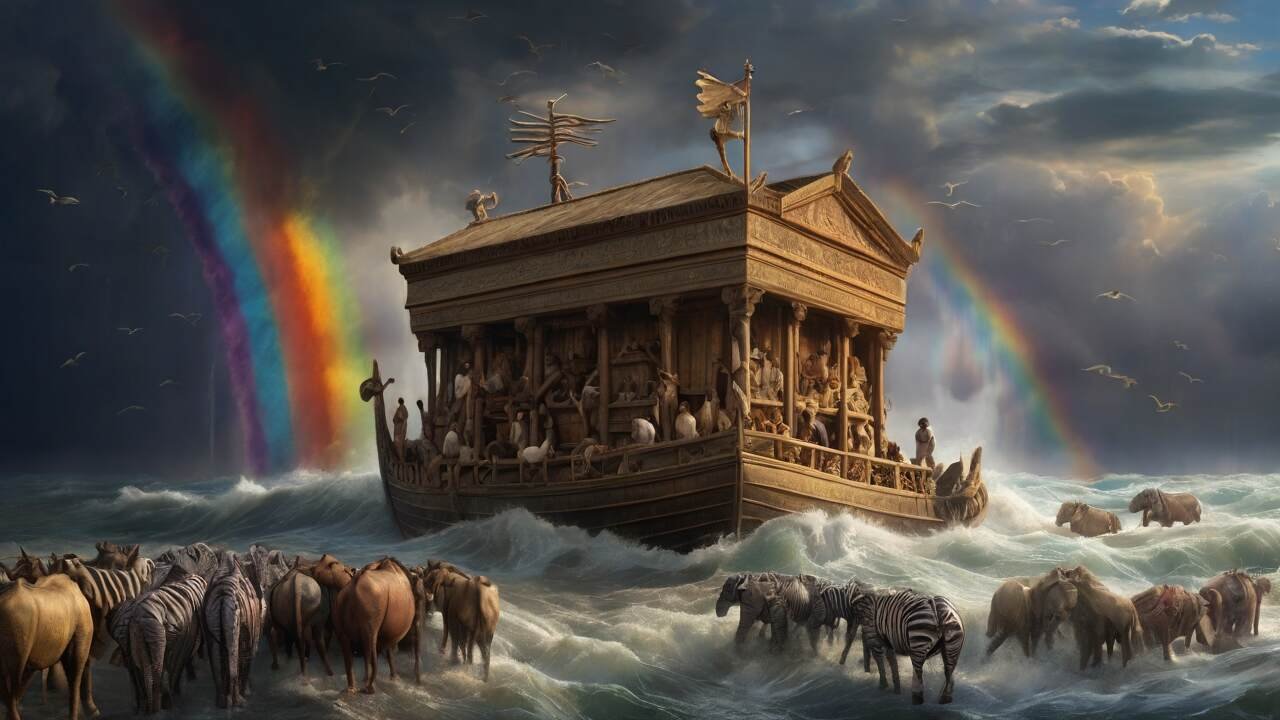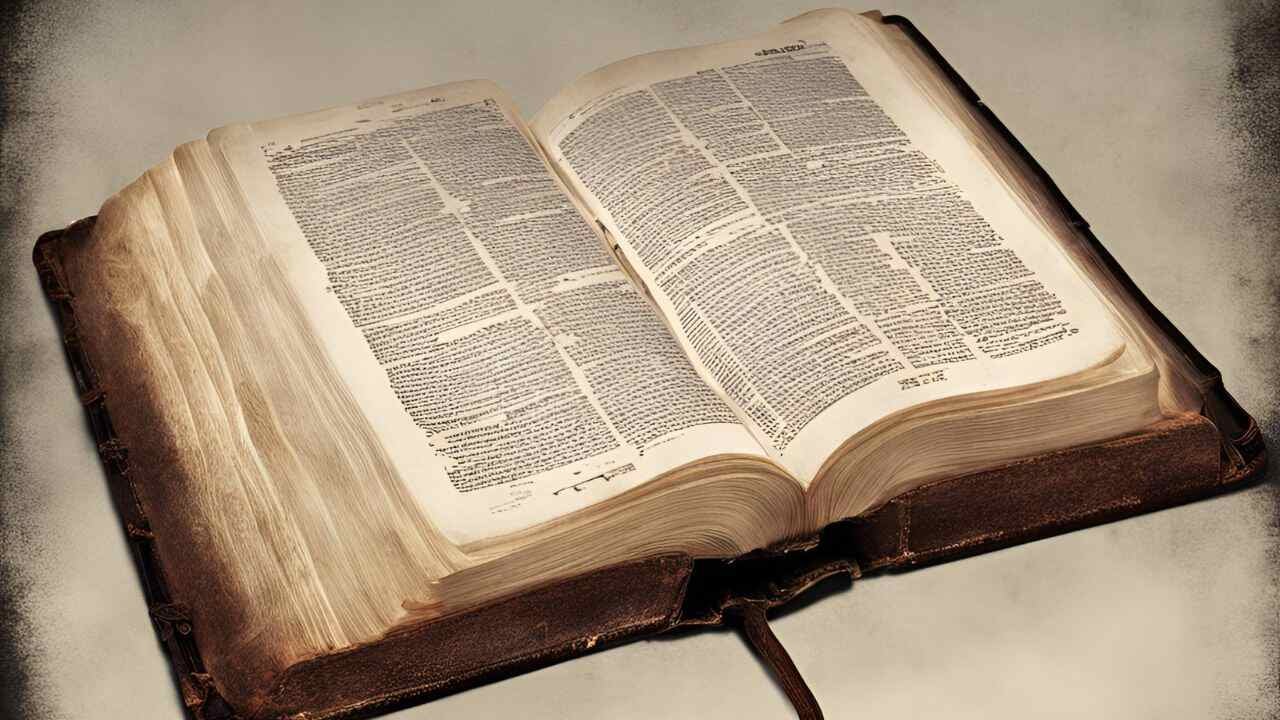The story of Noah’s Ark is an inspiring biblical narrative found in the Old Testament book of Genesis. It depicts how God, in response to the pervasive wickedness of humanity, decided to destroy the world with a global deluge. However, God instructed Noah, a righteous man, to build an ark to preserve himself, his family, and representatives of all animal life.
Through Noah’s obedience and faith, he was able to follow God’s instructions to construct the ark, gathering the animals and ultimately escaping the devastating flood that wiped out the rest of civilization. This biblical account not only highlights God’s judgment on sin, but also His mercy and provision of salvation for those who trust in Him.
Key Takeaways
- The story of Noah’s Ark is a compelling biblical narrative found in the Old Testament.
- God instructed Noah, a righteous man, to build an ark to preserve himself, his family, and representatives of all animal life.
- Through Noah’s obedience and faith, he was able to follow God’s instructions and escape the devastating global flood.
- The biblical account highlights both God’s judgment on sin and His mercy and provision of salvation for those who trust in Him.
- The story of Noah’s Ark is a testament to the power of faith and the importance of heeding God’s instructions.
The Story of Noah’s Ark: A Divine Judgment and Mercy
According to the Biblical account in the book of Genesis, the world had descended into a state of profound wickedness and apostasy, where “every intent of the thoughts of [man’s] heart was only evil continually” (Genesis 6:5). The level of depravity had reached such a point that “the LORD was sorry that He had made man on the earth, and He was grieved in His heart” (Genesis 6:6).
God’s Judgment on the Wicked
In response to this widespread anarchy and ungodly philosophy, God determined to bring a devastating global deluge to cleanse the earth of its wickedness. The Bible recounts how “the LORD saw that the wickedness of man was great in the earth, and that every intent of the thoughts of his heart was only evil continually” (Genesis 6:5).
Grieved by the state of humanity, God decided to “destroy man whom I have created from the face of the earth” (Genesis 6:7). However, amidst this impending judgment, Noah found grace in the eyes of the Lord, for “Noah was a just man, perfect in his generations. Noah walked with God” (Genesis 6:9).
The divine judgment that was to come upon the world would serve as a preview of the final judgment that will one day encompass all of humanity, as referenced by Jesus and the apostle Peter in the New Testament. This sobering reality underscores the urgent need for repentance and a return to godly living.
Noah’s Obedience and Faith
The biblical narrative portrays Noah as a man of unwavering faith and unwavering obedience to God’s divine instructions. When the Almighty commanded Noah to “Make yourself an ark” (Genesis 6:14) in preparation for the impending global flood, Noah diligently followed God’s directives, even though such a catastrophic deluge had never been witnessed before.
Noah’s steadfast trust in God’s word and his tireless perseverance in constructing the massive ark over many years demonstrated his unshakable belief in the divine plan for salvation. Additionally, Noah’s obedient effort in gathering and preserving representatives of all animal life on the ark showcased his unwavering commitment to God’s instructions for the preservation of creation.
Through Noah’s faithful response, he and his family were spared from the devastating judgment that befell the rest of humanity. This act of divine guidance and salvation has cemented Noah’s legacy as a beacon of hope and a testament to the power of unwavering faith in the face of seemingly insurmountable challenges.
“By faith Noah, being warned of God of things not seen as yet, moved with fear, prepared an ark to the saving of his house; by the which he condemned the world, and became heir of the righteousness which is by faith.” (Hebrews 11:7)
The remarkable story of Noah’s Ark stands as a timeless testament to the transformative power of faith, obedience, and divine guidance. Through his unwavering commitment to God’s plan, Noah not only secured his own family’s salvation but also played a crucial role in the preservation of animal life on Earth, ensuring the continued flourishing of creation.
Summarize the story of Noah’s Ark as depicted in the King James Bible
The story of Noah’s Ark, as depicted in the King James Bible, is a captivating narrative that has inspired generations of readers. This biblical tale, rooted in the Old Testament book of Genesis, recounts God’s judgment on the wicked and His offer of salvation to a righteous man named Noah.
According to the King James Bible, God observed the widespread corruption and wickedness that had consumed humanity, prompting Him to decide to destroy the world with a catastrophic flood. However, Noah, described as “a just man and perfect in his generations” (Genesis 6:9), found favor in God’s eyes. The Lord instructed Noah to build a massive ark to preserve himself, his family, and representatives of all animal life on Earth.
Despite the seemingly impossible task and the potential ridicule he faced, Noah faithfully obeyed God’s commands. He diligently constructed the ark and gathered the animals as directed, demonstrating his unwavering obedience and faith in the face of this divine directive.
When the floodwaters came, Noah and his family were safely sealed inside the ark, while the rest of civilization perished in the global deluge. After the flood subsided, Noah and his loved ones emerged, and God established a new covenant, promising never again to destroy the earth with a worldwide flood.
The story of Noah’s Ark, as recounted in the King James Bible, is a poignant tale of faith, obedience, and God’s enduring mercy. It serves as a powerful reminder of the consequences of sin and the importance of heeding divine instructions, even in the face of seemingly insurmountable challenges.
“And Noah did according unto all that the Lord commanded him” (Genesis 7:5).
The biblical narrative of Noah’s Ark, as presented in the King James Version, continues to captivate readers and holds profound lessons about the importance of faith, obedience, and the transformative power of God’s grace.
The Ark: A Symbol of Salvation
The biblical account of Noah’s Ark has long been recognized as a powerful symbol of salvation and divine protection. The ark itself, constructed of gopherwood and sealed with pitch, was designed by God to withstand the fury of the floodwaters, serving as a haven for Noah, his family, and representatives of all animal life.
The Ark’s Construction and Dimensions
The ark’s impressive dimensions, measuring 300 cubits in length, 50 cubits in width, and 30 cubits in height, provided ample space to house Noah’s family and the animals that were preserved. The ark’s shape, likened to a giant coffin, has been interpreted as a symbol of burial and rebirth, foreshadowing the way believers are “buried with Christ in baptism” (Romans 6:4).
Moreover, the ark’s lone window and side-mounted door, sealed by God, convey the idea of divine protection and salvation, with Noah and his family safe from the judgment that befell the rest of the world. This biblical symbolism underscores the ark’s role as a vessel of preservation and a testament to God’s power to save those who trust in His guidance.

“The ark was not just a means of physical salvation but a powerful metaphor for the spiritual salvation offered by God.”
The ark’s construction and dimensions, as described in the Bible, have captivated the imagination of believers and scholars alike, inspiring countless interpretations and artistic depictions. This enduring symbol of faith and divine intervention continues to hold profound meaning for those who seek to understand the depth of God’s love and the promise of salvation.
God’s Covenant and Promise
After the devastating flood that destroyed the wicked world, God made a remarkable new covenant with Noah and his family. This divine promise, detailed in the book of Genesis, would forever shape the course of human history.
At the heart of this new covenant was God’s solemn oath to never again destroy the earth with a global flood. As a tangible sign of this promise, God placed the rainbow in the sky, a symbol of His mercy and faithfulness. This divine promise of preservation offered a profound sense of security and hope for Noah and his descendants.
Moreover, God blessed Noah and his sons, instructing them to “be fruitful and multiply, and fill the earth” (Genesis 9:1). This blessing signified God’s continued purpose for humanity, even after the devastating judgment of the flood. It was a testament to His grace and His desire to see His creation thrive.
The new covenant and God’s divine promises of preservation and blessing would become a cornerstone of the Judeo-Christian tradition, shaping the lives of countless believers throughout history. This remarkable story of God’s mercy and faithfulness continues to inspire and encourage people of faith today.
“I will never again curse the ground because of man, for the intention of man’s heart is evil from his youth. Neither will I ever again strike down every living creature as I have done.” (Genesis 8:21)
| Key Elements of God’s Covenant with Noah | Description |
|---|---|
| Never Destroy the Earth by Flood | God promised to never again destroy the earth with a global flood, as He had done during the time of Noah. |
| Rainbow as a Sign of the Covenant | God placed the rainbow in the sky as a visible reminder of His promise and covenant with Noah. |
| Blessing and Instruction to Multiply | God blessed Noah and his sons, instructing them to “be fruitful and multiply, and fill the earth” (Genesis 9:1). |
Conclusion
The biblical narrative of Noah’s Ark is a timeless story that resonates with believers and non-believers alike. This account, as depicted in the King James Bible, serves as a powerful testament to the themes of divine judgment, faith, obedience, and ultimately, salvation. Through Noah’s unwavering trust in God and his willingness to follow the divine instructions, he and his family were spared from the devastating global flood that destroyed the rest of civilization.
This story not only reminds us of God’s righteous judgment on sin, but also His infinite mercy and grace. The establishment of a new covenant and the promise to never again destroy the earth in such a manner underscores the transformative power of faith and obedience. The ark, as a symbol of salvation, encourages believers to find refuge in God, even in the midst of a wicked and perishing world.
The biblical narrative of Noah’s Ark stands as a timeless testament to the enduring power of faith and the unwavering nature of God’s plan for His creation. This account continues to inspire and challenge readers to trust in the divine, no matter the circumstances, and to find solace in the promise of salvation that transcends the trials and tribulations of this world.
FAQ
What is the biblical narrative of Noah’s Ark?
The story of Noah’s Ark is an inspiring biblical narrative found in the Old Testament book of Genesis. It depicts how God, in response to the pervasive wickedness of humanity, decided to destroy the world with a global flood. However, God instructed Noah, a righteous man, to build an ark to preserve himself, his family, and representatives of all animal life.
How did Noah demonstrate his faith and obedience?
The Bible portrays Noah as a man of great faith and obedience. When God instructed him to build the ark in preparation for the impending flood, Noah diligently followed God’s commands, even though a global deluge had never been witnessed before. Noah’s unwavering faith in God’s word and his perseverance in building the massive ark over many years demonstrated his trust in the divine plan for salvation.
What are the key details of the story of Noah’s Ark as depicted in the King James Bible?
According to the King James Bible, God observed the widespread wickedness and corruption of humanity, and decided to destroy the world with a catastrophic flood. However, Noah, a righteous man, found favor in God’s eyes. God instructed Noah to build a massive ark to preserve himself, his family, and representatives of all animal life. Despite the seemingly impossible task, Noah faithfully obeyed God’s commands, constructing the ark and gathering the animals as directed.
What symbolism is associated with the ark?
The biblical account of Noah’s Ark has long been recognized as a powerful symbol of salvation and divine protection. The ark itself, constructed of gopherwood and sealed with pitch, was designed by God to withstand the fury of the floodwaters. Its impressive dimensions and shape, likened to a giant coffin, have been interpreted as symbols of burial and rebirth, foreshadowing the way believers are “buried with Christ in baptism”.
How did God establish a new covenant with Noah after the flood?
After the floodwaters receded and Noah, his family, and the animals emerged from the ark, God established a new covenant with Noah. This covenant included a divine promise that God would never again destroy the earth with a global flood. As a sign of this covenant, God placed the rainbow in the sky, a symbol of His mercy and faithfulness. Additionally, God blessed Noah and his sons, instructing them to “be fruitful and multiply, and fill the earth”.







